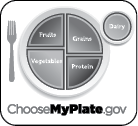- 1 c. all-purpose flour
- 1 c. whole-wheat flour
- ¾ c. sugar
- 2 tsp. baking soda
- 2 tsp. ground cinnamon
- ¼ tsp. salt
- ¾ c. egg substitute*
- ½ c. vegetable oil
- ½ c. unsweetened applesauce
- 2 tsp. vanilla extract
- 2 c. chopped apples (unpeeled)
- ½ c. raisins
- ¾ c. grated carrots
- 2 Tbsp. chopped pecans (optional)
Preheat oven to 350 degrees F. Sift or whisk together flour, sugar, baking soda, cinnamon and salt in a large bowl. Add the apples, raisins, carrots and nuts and stir to combine.
In a separate bowl, whisk the egg substitute with the oil, applesauce and vanilla. Pour into the bowl with the dry ingredients and blend well. Spoon the batter into muffin tins lined with muffin cups (or sprayed with cooking spray). Fill each to the brim. Bake for 30 to 35 minutes or until a toothpick inserted into the middle comes out clean. Cool muffins in the pan for 10 minutes, then turn out onto a rack to continue cooling.
*¾ cup egg substitute = 3 whole eggs
Makes 18 muffins. Each serving (one muffin) has 170 calories, 7 g fat, 25 g carbohydrate, 2 g fiber, 3 g protein and 200 mg sodium.
This recipe was modified by:
- Replacing half the all-purpose flour with whole-wheat flour
- Cutting the sugar in half
- Enhancing the sweet flavor by doubling the cinnamon and vanilla
- Reducing sodium by cutting salt in half
- Replacing each egg with ¼ c. egg substitute
- Reducing the fat by replacing half the oil with unsweetened applesauce
- Peels were left on the apples to increase fiber
- Coconut was replaced with an additional ¼ c. grated carrots


